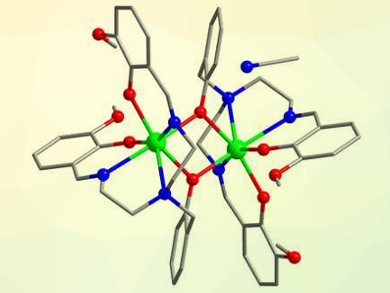Single-molecule magnets (SMMs) are complexes that show superparamagnetic behavior at the molecular scale below a certain blocking temperature. SMMs could have applications, e.g., in ultra-high-density storage materials, spintronic devices, and magnetic refrigerators. Rare-earth SMMs are particularly interesting because of their large magnetic moment and magnetic anisotropy. The magnetodynamic behavior of SMMs is very sensitive to their structure, and minor changes, such as introducing solvent molecules, can influence their magnetic behavior.
Yahong Li and her colleagues at Soochow University, Suzhou, China, have synthesized a series of seven heptacoordinated dinuclear lanthanide complexes of the types Dy2L2 (1) (H3L = 2-{[bis(2-hydroxy-3-ethoxybenzyl)(aminoethyl)amino]methyl}phenol) and Ln2L2·MeCN (Ln = Dy (2), Sm (3), Eu (4), Gd (5), Tb (6), Ho (7)). The reaction of Dy(NO3)3⋅6 H2O with one equivalent of H3L at 70 °C in DMF/EtOH under autogenous pressure gave compound 1. Complexes 2–7 were prepared by means of the same method as that used for 1, except DMF was replaced by MeCN as the reaction solvent and Dy(NO3)3⋅6 H2O was changed to the corresponding lanthanide salts.
The slight difference between 1 and 2–7 arises from the existence of free MeCN molecule in 2–7. The purposeful introduction of solvent MeCN molecule changes the crystal system from triclinic for Dy2L2 (1) to monoclinic for 2 and alters the Dy—O–Dy angles and Dy⋅⋅⋅Dy distances, consequentially resulting into dramatic influences on the magnetic properties of 1 and 2: Dy2L2 (1) complexes without solvent did not display SMM behavior. The complex 2 with free MeCN, Dy2L2·MeCN (pictured), in contrast, showed a field-induced slow magnetization relaxation behavior, indicating its SMM nature. The free solvent molecule tunes the single molecule magnetic behavior.
The experimental results were supported by complete active space self-consistent field (CASSCF) quantum chemical calculations. This work offers a strategy for inducing the SMM behavior in Dy2 compounds using solvents.
- Dinuclear Lanthanide Complexes Based on a Schiff-base Ligand: Free Lattice Solvent Inducing the Single Molecule Magnet Behavior of Dy2 Compound,
Yu Ge, Yaru Qin, Yanfeng Cui, Yangdan Pan, Yaun Huang, Yahong Li, Wei Liu, Yiquan Zhang,
Chem. Asian J. 2018.
https://doi.org/10.1002/asia.201801336




